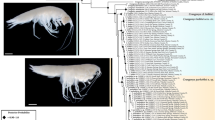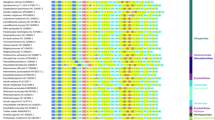Abstract.
Because the classification of extant and fossil articulate brachiopods is based largely upon shell characters observable in fossils, it identifies morphotaxa whose biological status can, in practice, best be inferred from estimates of genetic divergence. Allozyme polymorphism and restriction fragment length polymorphism of mitochondrial DNA (mtDNA RFLP) have been used to show that nuclear and mitochondrial genetic divergence between samples of the cancellothyridid brachiopods Terebratulina septentrionalis from Canada and T. retusa from Europe is compatible with biological speciation, but the genetic distances obtained were biased by methodological limitations. Here, we report estimates of divergence in 12S rDNA mitochondrial sequences within and between samples of these brachiopods. The sequence-based genetic distance between these samples (5.98±0.07% SE) is at least 10 times greater than within them and, since they also differ in a complex life-history trait, their species status is considered to be securely established. Divergence levels between 12S rDNA genes of three other cancellothyridids, T. unguicula from Alaska, T. crossei from near Japan, and Cancellothyris hedleyi from near Australia are higher than between the two North Atlantic species, and the mean nucleotide distance between all these cancellothyrids is similar to the mean distance between species of Littorina (Mollusca: Gastropoda). Sequences of both 12S and 16S genes from cancellothyridids and other short-looped brachiopod species show neither saturation nor lineage-specific rate differences and, when analysed with different outgroups, either separately or together, yield one unexpected, but well-supported, tree with Alaskan T. unguicula basal and C. hedleyi nested within Terebratulina, i.e. these genera are paraphyletic. A geologically dated divergence between Antarctic and New Zealand species of the short-looped brachiopod Liothyrella is used to calibrate the rate of 12S divergence at ca. 0.1% per million years (MY), and this rate is used to infer that T. septentrionalis and T. retusa have been diverging for ca. 60 MY and that they and T. unguicula have been diverging from their last common ancestor for ca. 100 MY. This indicates a Mesozoic origin for the present-day distribution of cancellothyridids and the basal position of T. unguicula suggests a possible North Pacific centre of origin, with separate Atlantic and Pacific radiations. The inclusion of Cancellothyris within Terebratulina also shows that adult shell characters such as umbo, foramen and symphytium shape, whilst probably indispensible for the practical classification of fossils, are not reliable guides to genealogy.
Similar content being viewed by others
Author information
Authors and Affiliations
Additional information
Electronic Publication
Rights and permissions
About this article
Cite this article
Lüter, .C., Cohen, .B. DNA sequence evidence for speciation, paraphyly and a Mesozoic dispersal of cancellothyridid articulate brachiopods. Marine Biology 141, 65–74 (2002). https://doi.org/10.1007/s00227-002-0808-7
Received:
Accepted:
Issue Date:
DOI: https://doi.org/10.1007/s00227-002-0808-7




